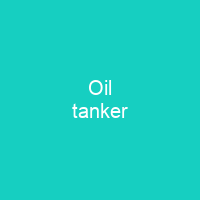What is an Oil Tanker and Why Does It Matter?
Imagine a colossal vessel, like a floating city, designed to transport vast quantities of crude oil or refined petroleum products across oceans. An oil tanker is that very ship—a marvel of modern engineering that plays a pivotal role in the global economy. These vessels are not just simple cargo carriers; they are the backbone of the oil industry, moving approximately 2 billion metric tons of oil annually at an average cost of $5-8 per cubic meter.
The Evolution of Oil Tankers
From humble beginnings in the late 19th century to today’s colossal supertankers, the journey of oil tanker design and technology is a fascinating tale. The first successful oil tanker, Zoroaster, was built in 1863, featuring two iron tanks joined by pipes. This early model laid the groundwork for future advancements. By the 1880s, Colonel Henry F. Swan designed tankers that addressed stability issues with cargo holds spanning the ship’s beam.
One of the most significant milestones in tanker history was the development of the modern oil tanker between 1877 and 1885 by Ludvig Nobel’s company Branobel. Nobel experimented with carrying oil on single-hulled barges, eventually leading to self-propelled tankships. The Zoroaster was a pioneering success, but it wasn’t until the Glückauf, built in 1883, that many consider the first modern oil tanker. This ship featured cargo valves operable from the deck, cargo main piping, and the ability to fill a ballast tank with seawater.
The Rise of Supertankers
As the demand for oil grew, so did the size of tankers. The world’s largest supertanker in 1955 was SS Spyros Niarchos, followed by Universe Apollo in 1958. In 1979, the Seawise Giant became the world’s largest supertanker with a capacity of 564,763 DWT (Deadweight Tonnage). This behemoth measured an impressive 458 ft long and 74 ft wide, carrying 2,000,000 barrels of oil. However, it met its end in 1988 when it was scrapped.
Today, the TI-class supertankers are currently the world’s largest working tankers, built as Hellespont Alhambra and Tara with a capacity of over 441,500 DWT. These vessels are not just large; they are marvels of engineering, designed to navigate the vast oceans efficiently.
Types of Oil Tankers
Oil tankers can be broadly classified into two types: crude tankers and product tankers. Crude tankers move unrefined crude oil from extraction points to refineries, while product tankers carry refined products to markets. Within these categories, there are further classifications based on size:
- Crude Carriers: These range from 55,000 DWT Panamax-sized vessels to ULCCs (Ultra Large Crude Carriers) of over 440,000 DWT.
- Product Tankers: Smaller tankers that carry refined petroleum products.
- Supertankers: Also known as very large and ultra-large crude carriers (VLCCs and ULCCs), these are the largest oil tankers with capacities over 250,000 DWT. They can transport up to 3,166,353 barrels of oil.
Chartering and Freight Rates
The act of hiring a ship to carry cargo is called chartering, with four types of agreements: voyage charter, time charter, bareboat charter, and contract of affreightment. The key aspect of any charter party includes the freight rate, which can be specified in one of four ways: lump sum rate, rate per ton, time charter equivalent rate, or Worldscale rate.
The Worldwide Tanker Normal Freight Scale (Worldscale) establishes a baseline price for carrying a metric ton of product between two ports. Charter parties negotiate prices based on a percentage of the Worldscale rate, with rates expressed as WS 100, WS 85, and so on. The market is affected by variables such as supply and demand of oil and tankers, influencing charter party negotiations and freight rates.
Environmental Impact and Safety
The environmental impact of oil spills cannot be overstated. Crude oil contains toxic substances that can last for years in the environment. Despite the risks, tanker owners’ organizations argue that the industry’s safety record is excellent, with only a tiny fraction of oil cargoes being spilled. However, large accidents do occur, and their consequences are severe.
Modern oil tankers carry large volumes of oil, posing a significant threat to the environment. The International Tanker Owners Pollution Federation tracked 9,351 accidental spills since 1974. Most operational oil spills are small, with 91% resulting in less than 7 metric tons of spillage. Large accidents cause bigger losses, with 84% involving over 700 metric tons.
To mitigate these risks, double-hull designs offer advantages in safety and environmental protection but come with higher build costs and operating expenses. The inert gas system is a crucial component that creates an atmosphere where hydrocarbon vapors cannot burn, ensuring safe entry into tanks by purging hydrocarbon vapors until the concentration is under 1%.
Conclusion
The oil tanker industry has come a long way since its early days. From Zoroaster to the Seawise Giant and beyond, these vessels have evolved to meet the demands of an ever-growing global market. While challenges remain, including environmental concerns and fluctuating markets, the role of oil tankers in transporting the world’s energy needs remains indispensable.
As we look to the future, it is clear that innovation will continue to shape this industry, ensuring safer, more efficient, and environmentally friendly transportation of oil. The journey of an oil tanker from its port of origin to its destination is a testament to human ingenuity and the relentless pursuit of progress in maritime technology.

You want to know more about Oil tanker?
This page is based on the article Oil tanker published in Wikipedia (retrieved on December 26, 2024) and was automatically summarized using artificial intelligence.





